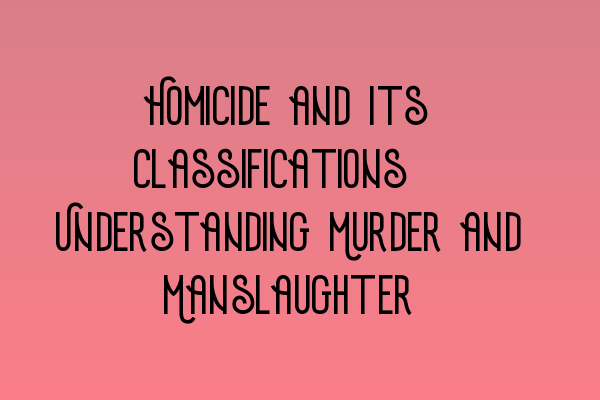Homicide and Its Classifications: Understanding Murder and Manslaughter
Welcome to SQE Criminal Law & Practice Law UK! In this blog post, we will delve into the complex world of homicide and its classifications. Homicide refers to the unlawful killing of a human being, and it is a serious offense that comes with severe legal consequences. It is important to have a clear understanding of the different types of homicide, namely murder and manslaughter, to navigate the criminal justice system effectively.
What is Murder?
Murder is the most serious form of homicide. It involves the intentional killing of another person with malice aforethought. Malice aforethought refers to the intent to cause death or serious bodily harm with knowledge of the potential consequences. Murder can be further classified into different degrees, depending on the circumstances surrounding the act.
First-degree murder is the deliberate and premeditated killing of another person. This involves planning and a clear intent to cause death. Second-degree murder, on the other hand, is an intentional killing without premeditation or planning. It may happen in the heat of the moment or as a result of a dangerous act.
If you are interested in expanding your expertise in criminal practice, we offer workshops and seminars on criminal practice that can help enhance your knowledge and skills in this field.
What is Manslaughter?
Manslaughter, unlike murder, involves unlawfully causing the death of another person without malice aforethought. It is usually characterized by a lack of intent to kill, although the act may still be intentional. Manslaughter can be classified into two different categories: voluntary manslaughter and involuntary manslaughter.
Voluntary manslaughter occurs when the killing is committed in the heat of passion or during a sudden quarrel. It is not premeditated and lacks malice aforethought. Involuntary manslaughter, on the other hand, refers to unintentional killings resulting from reckless or negligent conduct. This can include cases where a person’s actions lead to the death of another, even if they did not intend to cause harm.
If you want to enhance your SQE criminal law study group experience, we have a dedicated article on enhancing your SQE criminal law study group experience that provides valuable insights and techniques.
Understanding the Differences
The key difference between murder and manslaughter lies in the presence or absence of malice aforethought and intent. While murder involves intentional killings with malice aforethought, manslaughter encompasses unlawful killings without malice aforethought or with a less severe level of intent.
It is important to consult with an experienced criminal law solicitor if you are involved in a homicide case. They can help analyze the specific circumstances of the case and provide guidance on the appropriate legal defenses and strategies.
Further Resources
To gain a comprehensive understanding of criminal evidence rules, we recommend reading our article on decoding criminal evidence rules. It provides in-depth analysis and insights into the complexities of criminal evidence in the UK.
For a closer look at state prosecution in the UK, our article on public prosecutions in the UK provides valuable information on the role of the state in prosecuting criminal cases.
If you’re curious about UK police procedures in criminal cases, you can find an inside look in our article on uncovering UK police procedures in criminal cases.
We hope this article has provided you with a better understanding of homicide, murder, and manslaughter. Remember, seeking professional legal advice is crucial if you find yourself facing homicide charges or involved in a homicide case. Stay informed, stay prepared, and ensure your rights are protected.
